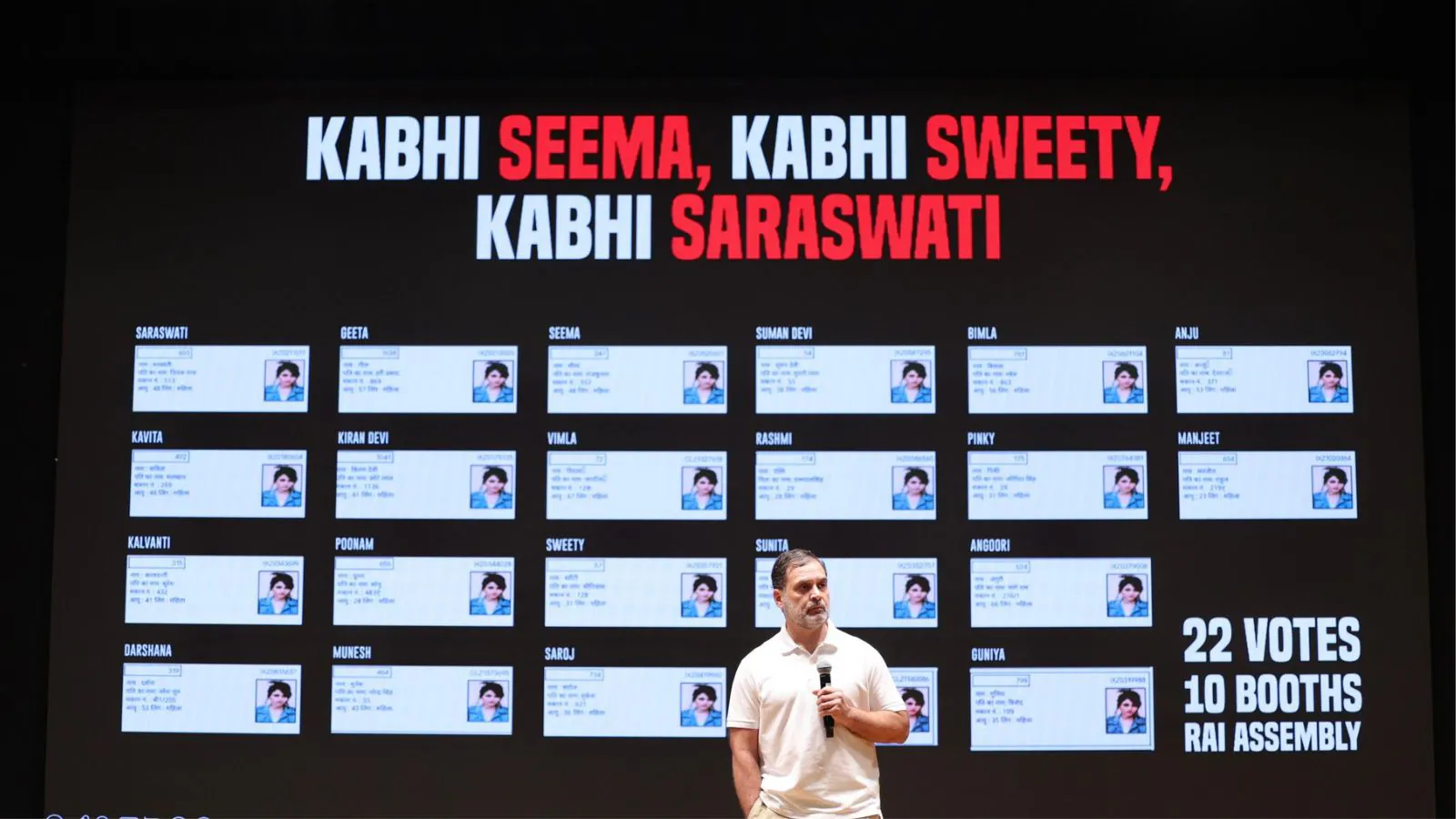Copyright news18

On November 7, 2025, Rahul Gandhi, India’s Leader of the Opposition, held a press conference accusing the ruling party and the Election Commission of India (ECI) of orchestrating “wholesale vote theft”. He alleged that “chunav chori” had distorted the 2024 Haryana state election and claimed tens of lakhs of votes were improperly cast. The accusations revived a now-familiar pattern in India’s politics: electoral defeat recast as systemic betrayal, and public scepticism mobilised as a political tool. The sequence has become predictable — lose an election, allege irregularities, disregard court observations or ECI clarifications, and then craft a narrative aimed especially at younger voters less familiar with procedural details. Such narratives do not strengthen democracy; they undermine trust in the very institutions that allow India’s vast electorate to vote freely and regularly. For a global audience observing the world’s largest democracy, the shift from evidence-based critique to speculation-based rhetoric is significant. India’s electoral system — one of the most complex logistical operations in the world — has historically been admired for its ability to conduct peaceful, timely elections involving hundreds of millions of voters. Yet today its credibility is increasingly questioned not with verified data but with claims rooted in political disappointment. This growing tension between institutional performance and political messaging now frames much of India’s democratic debate. Haryana’s Margins: Normal Democratic Outcomes Cast as Suspicious The Haryana election became the immediate backdrop to these accusations. Rahul Gandhi argued that Congress lost eight constituencies by a combined margin of 22,000 votes, implying deliberate distortion. Narrow margins, however, are neither new nor suspicious. In established democracies—from India to the US to the UK—close contests are common and often decisive. Haryana’s tight margins affected candidates across parties, with several seats decided by extremely small vote gaps. Nationally, in the 2024 general election, the Bharatiya Janata Party (BJP) fell short of an absolute majority after losing a range of competitive seats, including some with close contests. Such narrow outcomes — whether benefiting or hurting any party — are a routine feature of India’s elections and are generally accepted as part of democratic competition. Close results are simply evidence of a competitive polity, not signs of fraud. Treating narrow losses as suspicious only when they affect one party converts a normal democratic outcome into a manufactured grievance. For international readers, this illustrates how political actors can exploit statistical coincidence to portray institutions as unreliable even without proof. Exit Polls, Postal Ballots and the Making of Doubt A second dimension of distrust stems from selective treatment of exit polls. When exit polls in Haryana and Maharashtra predicted a Congress advantage, they were celebrated as validation. When actual results diverged, the same polls were cited as evidence that “something went wrong.” Yet in other states—such as Jharkhand and Himachal Pradesh—exit polls favoured the BJP while the opposition ultimately won, and no accusations of rigging followed. Globally, exit polls are regarded as imperfect tools. They rely on limited samples and are vulnerable to turnout shifts and respondent bias. Treating them as authoritative when they align with one’s expectations and fraudulent when they do not is an opportunistic distortion. Postal ballots received similar treatment. In Haryana, only 0.57% of total votes were postal ballots. Expecting this tiny fraction to dictate overall results is statistically unreasonable. History supports this: in the 2015 Bihar election, postal ballots leaned one way while the overall result went another. Postal ballot trends have never been considered predictive of full results, not in India nor in major democracies. Turning them into supposed proof of manipulation misrepresents how elections function. For global readers, this is comparable to treating absentee ballots in the United States as the definitive indicator of national outcomes and alleging fraud when the broader electorate votes differently. It reflects a misunderstanding of electoral systems rather than evidence of wrongdoing. The ‘Duplicate Voter’ Claims and the Politics of Omission Perhaps the most dramatic allegations involved claims of “duplicate voters” and supposed misuse of photographs in Haryana’s voter rolls. Rahul Gandhi highlighted a case where a Brazilian woman’s image allegedly appeared 22 times in the rolls. Yet the woman later clarified she had never visited India, indicating that her image—likely taken from the internet—could not meaningfully support claims of organised voter fraud. The issue here is less about one image and more about how easily unverified visuals become political ammunition. Instead of demonstrating systemic voter manipulation, the incident exposed the fragility of evidence used to justify sweeping accusations. Further, many of the constituencies cited as having high numbers of alleged duplicate voters— Nuh, Punahana and Ferozepur Jhirka — are long-standing Congress strongholds with Muslim majority populations. If problematic entries existed, they existed for years and benefited the same political actors now citing them as evidence of fraud. This selective outrage raises the question of whether the goal is institutional reform or political theatre. Another viral case involved a woman called Anjali Tyagi whose name was missing from the voter roll and whose experience was used as an example of “vote theft.” She later clarified her vote was not stolen and that the omission likely stemmed from administrative error. Instead of being treated as a logistical issue requiring improvement, the case was used to amplify a narrative of conspiracy. Democracy’s Strength Lies in Trust, Not Spectacle A look at procedural records paints a very different picture from the one presented in accusations. For the Haryana election, draft rolls were published well in advance; more than 400,000 claims and objections were processed; final lists were shared with candidates weeks ahead of voting; and more than 20,000 polling stations were monitored by tens of thousands of agents from all parties. At the end of the process, there were only five formal complaints on counting day. For an electorate of millions, such a low number reflects procedural robustness, not failure. Yet these details rarely make headlines because spectacle spreads faster than accuracy. As seen in countries from Brazil to the United States, narratives of electoral misconduct often thrive not on proof but on public doubt. Once trust erodes, the system’s legitimacy suffers—not because it fails administratively, but because citizens begin to believe it has. India’s institutions, like those in any democracy, are imperfect and require ongoing scrutiny. Defending them does not mean defending any ruling party; it means defending the principle that electoral defeat cannot be casually rebranded as institutional sabotage. When political actors frame every loss as evidence of conspiracy, the message to Gen-Z voters is that the democratic process itself cannot be trusted. A healthy democracy requires the ability to reflect honestly after a setback. But instead of examining his party’s weaknesses, Rahul Gandhi has chosen to blame the system itself. Rather than introspecting, rebuilding, and understanding why voters did not side with him, he has framed defeat as evidence of institutional failure. It is an approach that may offer short-term political comfort, but it risks long-term damage to public trust. Ultimately, defending democratic institutions is not about taking a party’s side — it is about protecting the credibility of the process. Leaders come and go, parties win and lose, but the legitimacy of India’s democratic framework must remain stronger than the narratives built around any single defeat. Zahack Tanvir is an Indian-origin activist and founder of The Milli Chronicle, a UK-based publication. With expertise in geopolitics and counter-extremism, he provides insights into global affairs. He holds certifications in Counterterrorism from the University of Leiden of Netherlands, and Georgetown University of Washington DC. He tweets under @ZahackTanvir. Views expressed in the above piece are personal and solely those of the author. They do not necessarily reflect News18’s views.



